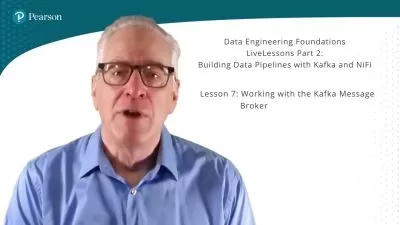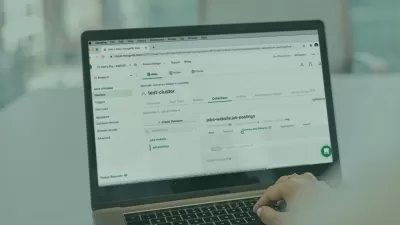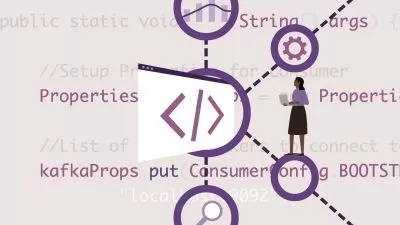The Complete Apache Kafka Practical Guide
Bogdan Stashchuk | Software Engineer, MBA, PhD
8:36:05
Description
Learn core Apache Kafka features, create Java, Node.js, Python Producers and Consumers - Full Kafka hands-on experience!
What You'll Learn?
- Understand how Apache Kafka works
- Create fault-tolerant clusters with topics replication across multiple brokers
- Apache Kafka Architecture
- How to create Kafka cluster with multiple Brokers
- Practice to create producers and consumers using built-in console producer and console consumer
- Write custom producer and consumer in Java
- Use Python and Node to produce and consume messages
- Learn components of the Apache Kafka Cluster
Who is this for?
What You Need to Know?
More details
DescriptionThis course is all about Apache Kafka
Understand HOW Apache Kafka works and learn its core features ONÂ PRACTICE. This is 80% practice course without no useless demos!
Build custom Apache Kafka Producers and Consumers using native Java API. Also you will build projects using APIs for other programming languages like Node.js and Python.
Become a master of Apache Kafka by understanding and practicing its architecture and main features.
All project files and mostly used commands are available in the GitHub repository.
This is the most complete practical Apache Kafka guide here on Udemy that includes tons of practical activities. Most important is that you will learn how Apache Kafka works and knowing it you will be able much more easier use its features and fix mistakes in the future after you'll finish this course. You can have zero knowledge about Apache Kafka, Java, Node.js or Python. All will be taught from scratch, from basic to advanced features. If you want to get deep knowledge of Apache Kafka this course is for you!
We will start by installing Apache Kafka on your computer, VPS (Virtual Private Server) or Virtual Machine on your computer. You will learn that installation of Apache Kafka is pretty easy - you just need to download archive with executable scripts and run them. Also you will learn and practice how to run multiple brokers on the same computer.
Afterwards we will jump into tons of practice activities and use different Apache Kafka features and built-in scripts. You will launch Zookeeper, multiple Brokers, Console Consumer and Console Producer. Also you will test performance of the Kafka Cluster using built-in utility called Performance Monitor.
In practice sections you will perform multiple practice Apache activities:
Create cluster with multiple brokers
Create topic with multiple partitions spread across different brokers
Create topics with replication factor that allows you to store copy of every message on different brokers for redundancy
Produce messages using built-in Console Producer
Consume messages using built-in Console Consumer
Launch multiple consumers in the same consumer group
Launch Performance Monitor for testing Consumers and Producers performance and speed
You will also learn and practice how to use Apache Kafka API to create your own Consumers and Producers
Create Java Maven project
Launch Producer and Consumer using Java
Launch multiple consumers in the same Consumer Group
Understand and practice difference between "subscribe" and "assign"
Create Node.js project
Launch Producers and Consumers using Node.js
Create Python project
Launch Producers and Consumers using Python
During the course you will need to view and edit text files. For that you will NOT use terminal. Instead you will use GUI application VisualStudio Code. Also all configuration files and project files are available in the GitHub repository. This means that during this course you will also learn how to use :
Git and GitHub
VisualStudio Code
With this course you will get lifetime-long access to more than 100 lectures and tens of practical exercises. After the course you will become a guru of Apache Kafka and will be able easily create custom Apache Kafka Producers and Consumers.
But most important is that you will UNDERSTAND Apache Kafka.
You will also get 30-days money-back guarantee. No questions asked!
Don't wait and join the course now!
Who this course is for:
- Beginners who want to learn Apache Kafka
- Advanced Apache Kafka users who want to learn how to build producers and consumers in other languages like Node or Python
- This course is for you if you want to PRACTICE using Kafka and it's APIs
This course is all about Apache Kafka
Understand HOW Apache Kafka works and learn its core features ONÂ PRACTICE. This is 80% practice course without no useless demos!
Build custom Apache Kafka Producers and Consumers using native Java API. Also you will build projects using APIs for other programming languages like Node.js and Python.
Become a master of Apache Kafka by understanding and practicing its architecture and main features.
All project files and mostly used commands are available in the GitHub repository.
This is the most complete practical Apache Kafka guide here on Udemy that includes tons of practical activities. Most important is that you will learn how Apache Kafka works and knowing it you will be able much more easier use its features and fix mistakes in the future after you'll finish this course. You can have zero knowledge about Apache Kafka, Java, Node.js or Python. All will be taught from scratch, from basic to advanced features. If you want to get deep knowledge of Apache Kafka this course is for you!
We will start by installing Apache Kafka on your computer, VPS (Virtual Private Server) or Virtual Machine on your computer. You will learn that installation of Apache Kafka is pretty easy - you just need to download archive with executable scripts and run them. Also you will learn and practice how to run multiple brokers on the same computer.
Afterwards we will jump into tons of practice activities and use different Apache Kafka features and built-in scripts. You will launch Zookeeper, multiple Brokers, Console Consumer and Console Producer. Also you will test performance of the Kafka Cluster using built-in utility called Performance Monitor.
In practice sections you will perform multiple practice Apache activities:
Create cluster with multiple brokers
Create topic with multiple partitions spread across different brokers
Create topics with replication factor that allows you to store copy of every message on different brokers for redundancy
Produce messages using built-in Console Producer
Consume messages using built-in Console Consumer
Launch multiple consumers in the same consumer group
Launch Performance Monitor for testing Consumers and Producers performance and speed
You will also learn and practice how to use Apache Kafka API to create your own Consumers and Producers
Create Java Maven project
Launch Producer and Consumer using Java
Launch multiple consumers in the same Consumer Group
Understand and practice difference between "subscribe" and "assign"
Create Node.js project
Launch Producers and Consumers using Node.js
Create Python project
Launch Producers and Consumers using Python
During the course you will need to view and edit text files. For that you will NOT use terminal. Instead you will use GUI application VisualStudio Code. Also all configuration files and project files are available in the GitHub repository. This means that during this course you will also learn how to use :
Git and GitHub
VisualStudio Code
With this course you will get lifetime-long access to more than 100 lectures and tens of practical exercises. After the course you will become a guru of Apache Kafka and will be able easily create custom Apache Kafka Producers and Consumers.
But most important is that you will UNDERSTAND Apache Kafka.
You will also get 30-days money-back guarantee. No questions asked!
Don't wait and join the course now!
Who this course is for:
- Beginners who want to learn Apache Kafka
- Advanced Apache Kafka users who want to learn how to build producers and consumers in other languages like Node or Python
- This course is for you if you want to PRACTICE using Kafka and it's APIs
User Reviews
Rating
Bogdan Stashchuk | Software Engineer, MBA, PhD
Instructor's Courses
Udemy
View courses Udemy- language english
- Training sessions 129
- duration 8:36:05
- English subtitles has
- Release Date 2024/03/13










